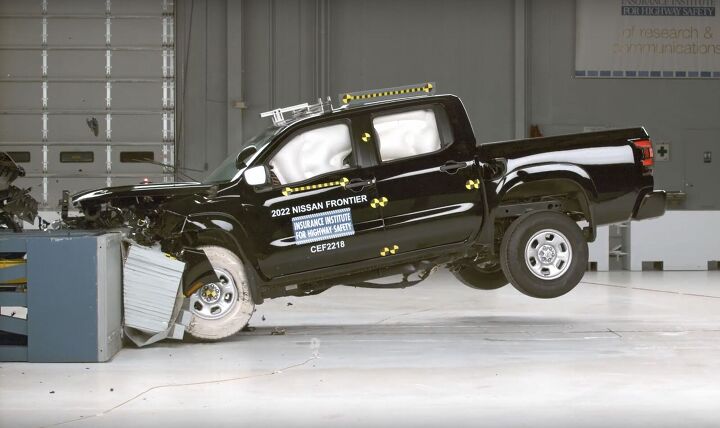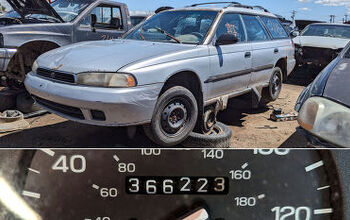IIHS Says Midsize Pickups Need More Passenger Protection

The Insurance Institute for Highway Safety (IIHS) believes that the rear-seat passengers of modestly sized pickups could be better protected after running a few through its updated moderate overlap frontal crash test.
While the group rated the Nissan Frontier as “acceptable,” crew-cabbed versions of the Ford Ranger only garnered a “marginal” classification. That left four-door versions of the Chevrolet Colorado, Jeep Gladiator, and Toyota Tacoma with “poor” ratings. No pickup managed to receive a “good” safety score, with the IIHS highlighting concerns about the possibility of chest, head, and neck injuries.
It likewise expressed general dissatisfaction with the restraint systems in the backs of most midsize crew cabs. However, the group has placed a renewed emphasis on rear-seat safety after having an assessment made on small passenger cars earlier this year.
You should know how the game works by now. The IIHS updates its testing protocols, whips a few automobiles into the wall, and comes to the conclusion that the whole industry needs to improve safety. Manufacturers then make the necessary changes to ensure a desirable score and the whole thing resets after a few years. If we’re lucky, we all end up with slightly safer vehicles that don’t cost or weigh significantly more than their predecessors.
But let’s not pretend like the passenger compartments on pickup trucks haven’t come a long way. Crew cabs haven’t been the norm forever. We used to call them “double cabs” back when regular cabs were actually the regular pickup configuration and typically offered a basic bench seat lacking any kind of shoulder restraints.
Vintage extended cabs (AKA super cabs) were even worse, especially on the smaller models. As a boy, my family briefly owned a Chevrolet S-10 “Maxi-Cab” (pictured above) with inward-facing jump seats. They came exclusively with lap restraints and were positioned so that my skull was guaranteed to bounce between the pickup’s side and rear glass during a collision. It was a novel solution and worked well enough to cram a few extra bodies into the truck with room left over for a couple of shallow cup holders. But it would be considered a death trap by modern standards.
Still, that doesn’t mean we shouldn’t load new models up with dummies before launching them down the runway to see what happens. In the pickup test, the IIHS pulled the vehicles along a 600-foot track so they collided with a barrier with 40 percent of the impact hitting the front of the vehicle at 40 miles an hour. Dummies (the rear one being child-sized) are painted to see where they make contact with the interior and are equipped with sensors that help estimate force. The event is likewise covered by as many cameras as possible, with several being mounted inside the cabin.
“Our updated moderate overlap front crash test proved to be challenging for small pickups,” said IIHS President David Harkey. “A common problem was that the rear passenger dummy's head came dangerously close to the front seatback, and in many cases, dummy measurements indicated a risk of neck or chest injuries. All these things tell us that the rear seat belts need improvement.”
From the IIHS:
All five small pickups provided good protection in the front seat. However, measurements indicated a slightly higher risk of leg or foot injuries to the driver in the Gladiator and Tacoma.
In the Colorado, Frontier, Ranger and Tacoma, the restraints in the back seat allowed the rear dummy’s head to come too close to the front seatback. That was not an issue for the Gladiator. However, its rear restraints do not include a side curtain airbag, increasing the risk of injury from a hard impact with the interior of the vehicle or even something outside it.
In the Ranger, the rear dummy submarined beneath the lap belt, causing it to ride up from the ideal position on the pelvis onto the abdomen, which increases the risk of internal injuries.
Otherwise, injury measures taken from the rear dummy indicated a moderate or likely risk of both neck and chest injuries in the poor-rated Colorado, Gladiator and Tacoma and a moderate risk of chest injuries in the marginal-rated Ranger.
So far, the IIHS has tested a handful of popular cars and 28 crossovers/SUVs under its new testing protocols.
The vast majority of those vehicles failed to earn a coveted “good” safety rating. Only the Ford Explorer, Ford Mustang Mach-E, Ford Escape, Subaru Ascent, Tesla Model Y, and Volvo XC40 passed with full marks. However, it should be noted that the IIHS has not run every vehicle currently on sale and will definitely have some blind spots. Testing every single model and trim is time-consuming and ultimately unrealistic, so it’s on you to do some of your own research.
That said, the group seems very keen on having manufacturers update their rear restraint systems and appears to be focusing on the issue like it previously did with headlight glare. This is likely to remain the organization's main focus for the next couple of years.
A detailed breakdown of the individual midsize pickup safety ratings is available at the Insurance Institute for Highway Safety's website and we're providing links to relevant crash test footage for the Chevrolet Colorado, Ford Ranger, Jeep Gladiator, Nissan Frontier, and Toyota Tacoma here.
[Images: IIHS; General Motors]
Become a TTAC insider. Get the latest news, features, TTAC takes, and everything else that gets to the truth about cars first by subscribing to our newsletter.

A staunch consumer advocate tracking industry trends and regulation. Before joining TTAC, Matt spent a decade working for marketing and research firms based in NYC. Clients included several of the world’s largest automakers, global tire brands, and aftermarket part suppliers. Dissatisfied with the corporate world and resentful of having to wear suits everyday, he pivoted to writing about cars. Since then, that man has become an ardent supporter of the right-to-repair movement, been interviewed on the auto industry by national radio broadcasts, driven more rental cars than anyone ever should, participated in amateur rallying events, and received the requisite minimum training as sanctioned by the SCCA. Handy with a wrench, Matt grew up surrounded by Detroit auto workers and managed to get a pizza delivery job before he was legally eligible. He later found himself driving box trucks through Manhattan, guaranteeing future sympathy for actual truckers. He continues to conduct research pertaining to the automotive sector as an independent contractor and has since moved back to his native Michigan, closer to where the cars are born. A contrarian, Matt claims to prefer understeer — stating that front and all-wheel drive vehicles cater best to his driving style.
More by Matt Posky
Latest Car Reviews
Read moreLatest Product Reviews
Read moreRecent Comments
- Ted The automotive period we are in reminds me of the malaise era of the 70s and early 80s. Government emission mandates exceeded the available engineering capabilities of most auto makers (sans Honda). Mileage, performance, and reliability all decreased. It wasn’t until both fuel injection and electronic engine control became available that all three improved again.Seems BEVs are in a similar spot; battery technology needs breakthrough improvement, charging needs to be faster and more ubiquitous. As those things happen, BEVs will make more sense.Agree the aspirational mandates are ahead of the current technology and infrastructure.
- Golden2husky This was a common topic at work - kids learned how to drive, and now another car is needed. I was amazed at all the excuses made about how their kid must have a new car. Used cars are a "risk" for breakdown, they are not as safe, etc...which is all BS of course. How much difference in safety is there between a new car and the same model that is five years old? Maintained cars don't break down very often. I've driven cars for far, far longer than most and have been towed exactly twice in my entire driving career (about 800,000 miles). While I wouldn't put my daughter into a 15 year old car and let her drive across the country, I would be fine with a 5 year old car that was well cared for. Let's be realistic - new drivers are likely to get into a fender bender - why do that to a new car. I was thrilled to get an 8 year old car for college back in the day even though my folks could afford to buy all of us new cars if they wanted to. If you Want to buy your kid new, go ahead. Just don't freak out when they come home with a fresh dent.
- CanadaCraig Can you eventually go to prison for driving without a licence in the US?
- CanadaCraig To hell with the UAW.
- CanadaCraig First I'll answer the question. YES. Toyota, Mazda and Subaru are doing the right thing. That said... If only those pushing for an all EV world would care as much about the 1 BILLION earthlings that make less than $1 a day.







































Comments
Join the conversation
They could add more metal to beef them up, but then the contingent who can't park a fiat 500 between the lines will whine to no end about how big trucks have gotten...
You want safety?
Drive a Volvo.